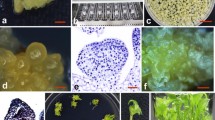Abstract
Salinity stress is one of the most serious factors limiting the distribution and productivity of crops and forest trees. The detrimental effects of salt on plants are a consequence of both a water deficit resulting in osmotic stress and the effects of excess sodium ions on critical biochemical process. A novel approach to improve salt tolerance has been established by using the technology of plant genetic transformation and using loblolly pine (Pinus taeda L.) as model plant. Mature zygotic embryos of loblolly pine were infected withAgrobacterium tumefaciens strain LBA 4404 harbouring the plasmid pBIGM which carrying the mannitol-1-phosphate dehydrogenase (Mt1D) and glucitol-6-phosphate dehydrogenase (GutD). Organogenic transgenic calli and transgenic regenerated plantltes were produced on selection medium containing 15mg/L kanamycin and confimed by Southern blot analysis of genomic DNA. Salt tolerance assays demonstrated that the salt tolerance of transgenic calli and regenerated plantlets were increased. These results suggested that an efficientAgrobacterium tumefaciens-mediated transformation protocol for stable integration of foreign genes into loblolloy pine has been developed and this could be useful for the future studies on engineering breeding of conifers.
Similar content being viewed by others
Abbreviations
- BA:
-
benzyladenine
- 2,4-D:
-
2,4-dichlorophenoxyacetic acid
- GutD:
-
glucitol-6-phosphate dehydrogenase
- IBA:
-
indole-3-butyric acid
- Mt1D:
-
mannitol-1-phosphate dehydrogenase
- nptll:
-
neomycin phosphotransferase II gene
References
Bergmann, B.A., Stomp, A.M. 1992. Effect of host plant genotype and growth rate onAgrobacterium tumefaciens-mediated gall formation inPinus radiata [J]. Phytopathology,82: 1457–1462.
Burdon, R.H., O’Kane, D., Fadzillah, N., Gill, V., Boyd, P.A. and Finch, R.R. 1996. Oxidative stress and responses inArabidopsis thaliana andOryza sativa subjected to chilling and salinity stress [J]. Biochem. Soc. Trans.,24: 468–472.
Diner, A.M., Karnosky, D.F. 1987. Differential responses of two conifers to in vitro inoculation withAgrobacterium rhizogenes [J]. Eur J For Path.,17: 211–216.
Ellis, D.D., McCabe, D.E., McInnis Ramachandran R, Russell D.R., Wallace, K.M.et al. 1993. Stable transformation ofPicea glauca by particle acceleration [J]. Biotechnology,11: 84–89.
Hoshida H., Tanaka, Y., Hibino, T., Hayashi, Y., Takabe, T. 2000. Enhanced tolerance to salt stress in transgenic rice that overexpresses chloroplast glutamine synthetase [J]. Plant Mol. Biol.,43: 103–111.
Huang, Y., Diner, A.M., Karnosky, D.F. 1991.Agrobacterium rhizogenes-mediated genetic transformation and regeneration of a conifer:Larix deciduas [J]. In Vitro Cell Dev. Biol.,27: 201–207.
Humara, J.M., Lopez, M., Ordas, R.J. 1999.Agrobacterium rhizogenes-mediated transformation ofPinus pinea L. cotyledons: an assessment of factors influencing the efficiency of uidA gene transfer [J]. Plant Cell Rep.,19: 51–58.
Klimaszewska, K., Devantier, Y., Lachance, D., Lelu, M.A., Charest, P.J. 1997.Larix laricina (tamarack): somatic embryogenesis and genetic transformation [J]. Can J For. Res.,27: 538–550.
Levee, V., Lelu, M.A., Jouanin, L., Comu D., Pilate, G. 1997.Agrobacterium tumefaciens-mediated transformation of hybrid larch (Larix kaempferi × L. decidua) and transgenic plant regeneration. Plant Cell Rep.,16: 680–685.
Li, J.J., Huang, X.X., Peng, X.X. 1995. Studies on high-efficient transgenic tobacco with salt resistance [J]. Chin. J. Biotech.,11: 381–384.
McKersie, B.D., Bowley, S.R., Harjanto, E. and Leprince O. 1996. Water-deficient tolerance and field performance of transgenic alfalfa overexpressing superoxide dismutase [J]. Plant Physiol.,111: 1177–1171.
Nomura, M., Ishitani, M., Takabe, T., Rai, A.K. and Takabe, T. 1995. Synechococcus sp. PCC7942 transformed withEscherichia coli bet genes produces glycine betaine from choline and acquires resistance to salt stress [J]. Plant Physiol.,107: 707–708.
Sambrook, J., Fritsch, E.F., Mamiatis, T. 1989. Molecular Cloning: a laboratory manual [M]. 2nd ed., New York: Cold Spring Harbor.
Sederoff, R., Stomp, A.M., Chilton, W.S., Moore, L.W. 1986. Gene transfer into loblolly pine byAgrobacterium tumefaciens [J]. Biotechnology,4: 647–649.
Serrano, R. 1996. Salt tolerance in plants and microorganisms: toxicity targets and defense responses [J]. Int. Rev. Cytol.165: 1–52.
Shin, D.I., Podila, G.K., Huang, Y., Karnosky, D.F. 1994. Transgenic larch expressing genes for herbicide and insect resistance [J]. Can. J. For. Res.,24: 2059–2067.
Stachel S.E., Messens, E., Montague, M.V., Zambryski, P. 1985. Identification of the signal molecules produced by wounded plant cells that activate T-DNA transfer inAgrobacterium tumefaciens [J]. Nature,318: 624–629.
Stomp, A.M., Weissinger, A., Sederoff, R.R. 1991. Transient expression from microprojectile-mediated DNA transfer inPinus taeda [J]. Plant Cell Rep.,10: 187–190.
Takabe, T., Nakamura, T., Nomura, M., Hayashi, Y., Ishitani, M., Muramoto, Y., Tanaka, A. and Takabe, T. 1998. Glycinebetaine and the genetic engineering of salinity tolerance in plants [C]. In: K. Satoh and N. Murata (Eds.), Stress Responses of Photosynthetic Organisms, Elsevier Science Publishers, Amsterdam, pp. 115–131.
Tang, W., Ouyang, F., Guo, Z.C. 1998. Plant regeneration through organogenesis from callus induced from mature zygotic embryos of loblolly pine [J]. Plant Cell Rep.,17: 557–560.
Tzfira, T., Yarnitzky, O., Vainstein, A., Altman, A. 1996.Agrobacterium rhizogenes-mediated DNA transfer inPinus halepensis Mill [J]. Plant Cell Rep.,16: 26–31.
Volkmar, K.M., Hu, Y. and Steppuhn, H. 1998. Physiological responses of plant to salinity: a review [J]. Can. J. Plant Sci.,78: 19–27.
Wagner, D.B., Furnier, G.R., Saghai-Maroof, M.A., Williams, S.M., Dancik, B.W., Allard, R.W. 1987. Chloroplast DNA polymorphisms in lodgepole and jack pine and their hybrids [J]. Proc. Natl Acad Sci. USA,84: 2097–2100.
Walter, C., Grace, L.J., Wagner, A., White, D.W.R., Walden, A.R., Donaldson, S.S., Hinton, H., Gardner, R.C., Smith, D.R. 1998. Stable transformation and regeneration of transgenic plants ofPinus radiata D. Don [J]. Plant Cell Rep.,17: 460–469.
Walter, C., Grace, L., Donaldson, S.S., Moody, J., Gemmell, J.E., van der Maos, S., Kvaalen, H., Lonneborg, A. 1999. An efficient Biolistic transformation protocol forPicea abies embryogenic tissue and regeneration of transgenic plants [J]. Can. J. For Res.,29: 1539–1546.
Yancey, P.H., Clark, M.E., Hand, S.C., Bowlus, P.D. and Somero, G.N., 1982. Living with water stress: evolution of osmolyte systems [J]. Science,217: 1214–1217.
Author information
Authors and Affiliations
Corresponding author
Additional information
Biography: TANG Wei (1964-), male, Ph. Doctor, Research associate, O-23, E. S. King Village, 2900 Ligon St., North Carolina State University, Raleigh, NC 27607, USA
Responsible editor: Chai Ruihai
Rights and permissions
About this article
Cite this article
Wei, T. Regeneration of transgenic loblolly pine expressing genes for salt tolerance. Journal of Forestry Research 13, 1–6 (2002). https://doi.org/10.1007/BF02857135
Received:
Issue Date:
DOI: https://doi.org/10.1007/BF02857135




